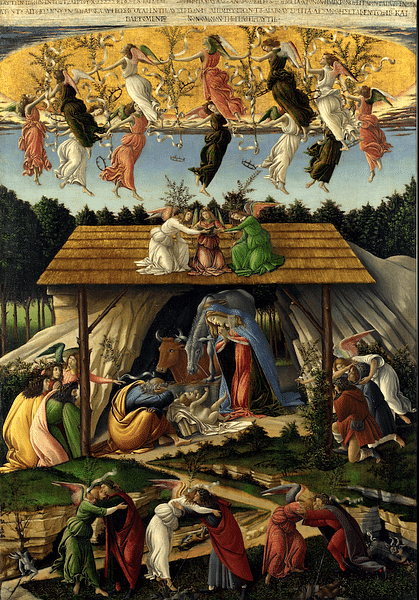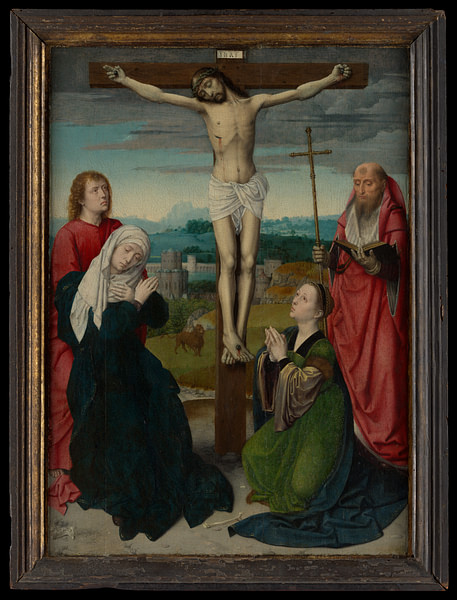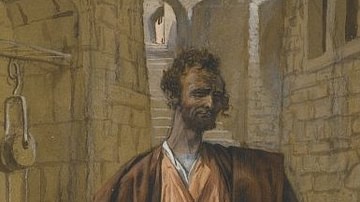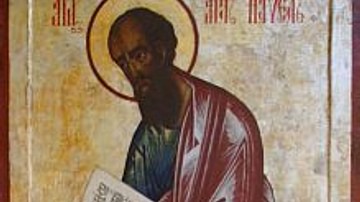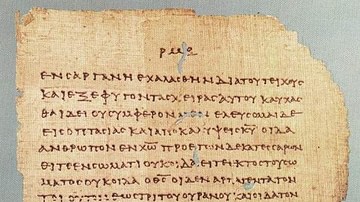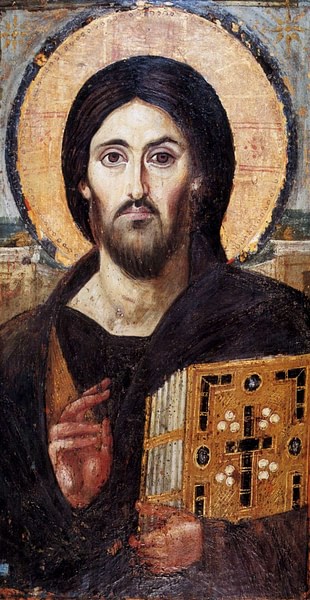
Jesus Christ is the designation of Jesus of Nazareth (d. c. 30 CE), who was an itinerant Jewish prophet from the Galilee in northern Israel. He preached the imminent intervention in human affairs by the God of the Jews, when God would establish his kingdom on earth. The proper name Jesus was Greek for the Hebrew Joshua ("he who saves"). 'Christ' (Greek: Christos) was translated from the Hebrew meshiach (messiah). 'Messiah' meant "anointed one" where anointing was part of the coronation ritual by God for Jewish kings. "Jesus the Christ" became shortened over time to Jesus Christ, beginning with the letters of Paul in the 50s and 60s of the 1st century CE. A popular title became his designation as the "son of God", both in function and nature.
Historical Context
The Jews were an ethnic group of various tribes who lived mainly in Israel but also settled in communities around the Mediterranean Basin. Collectively, they were known as the nation of Israel. They shared many religious elements with their neighbors but differed by having distinct dietary laws, practicing circumcision, and observing Sabbath (a day of rest every seven days). The other major difference was that while recognizing the various deities in the universe, they were only permitted to offer sacrifices to their God. This was done at the Temple complex in Jerusalem.
Over the centuries, the Jews had suffered the Assyrian Invasion (722 BCE), the destruction of Jerusalem and the Temple by the Babylonians (587 BCE), the occupation by the Greeks (167 BCE), and then Rome. When the Roman general Pompey (106-48 BCE) conquered the East, including Israel (63 BCE), he established client-kings who were responsible for keeping the peace, carrying out Roman dictates, and collecting taxes. Herod the Great was named King of the Jews (r. 37-4 BCE), and although he renovated the Temple complex in Jerusalem, he was reviled by many for his relationship with Rome.
Traditionally, the books of Jewish prophets (oracles) had blamed these events on the sins of the people, largely idolatry (worship of other gods). However, these prophets also offered a message of hope, known as Jewish Restoration Theology. They claimed that at some future time, God would intervene in history one final time to restore the nation of Israel and God would raise up a messiah to lead the armies of God against Israel's oppressors.
By the 1st century CE, there were many Jewish groups (sects) that maintained the traditions of Israel but varied in their lifestyles and attitude toward Rome and infamous for their debates among each other. Israel produced several charismatic messiah claimants, all calling for God's intervention against Roman rule. These men stirred up the crowds during religious festivals in Jerusalem, calling on God to destroy the Romans and establish his kingdom. Rome's response was to arrest and execute both the leader and his followers. The usual method of execution was crucifixion, the Roman punishment for treason as preaching a kingdom that was not Rome threatened the prosperity and stability of the Roman Empire.
The followers of Jesus of Nazareth became one more sect of Jews among many at the time. During the 20s CE, he proclaimed the message: "Repent, for the kingdom of God is at hand" (Mark 1.15). The claim was presented as "good news"; thus the later Anglo-Saxon term of 'gospel'.
The Dates for Jesus
Only two gospels, Matthew and Luke, present the nativity of Jesus, or the details surrounding the birth of Jesus. The dates are problematic. Matthew claimed that Jesus was born roughly two years before the death of Herod the Great (4 BCE), while Luke claimed he was born during the governorship of Quirinus in Syria (6 CE). Both relate that Mary, mother of Jesus, was impregnated by the spirit of God, resulting in the virgin birth.
All the gospel writers place the ministry and death of Jesus during the reign of the Roman procurator, Pontius Pilate. We know that Pilate reigned from 26-36 CE. By agreement, the common date for the death of Jesus falls between 30-33 CE.
The Ministry of Jesus in the Gospels
The ministry of Jesus began after he was baptized by a man known as John the Baptist. Baptism simply meant dunking. John was symbolically utilizing a water ritual after someone had repented of their sins. The ritual of baptism was one of the earliest Christian rituals and became part of the initiation of believers to enter the community.
Mark (the earliest gospel, c. 70 CE), presented Jesus as a charismatic exorcist, an itinerant preacher understood to have special gifts from God, operating through God's spirit, like the Prophets of Israel. Mark's Jesus traveled through the small towns and villages of Galilee, bringing his message that the prophets' prediction of the final days was imminent. According to Mark, Jesus taught through parables, which utilized everyday concepts and details to teach through examples. He called twelve disciples (students) to constitute his inner circle, symbolizing the restoration of the twelve tribes of Israel.
Beginning with Mark, the gospels relate that the Jewish leadership (mainly the Pharisees, scribes, and ultimately the Sadducees who were in charge of the Temple) was opposed to the teachings of Jesus from the very beginning of the ministry. Jesus and his disciples traveled to Jerusalem to celebrate the Passover festival. Jesus then went to the Temple Mount and disrupted the services of the animal-sellers and the money-changers. According to Mark, it is this event that led to the death of Jesus. After celebrating the Passover meal (which would become the Christian ritual of the Last Supper), Jesus and the disciples walked to the Mount of Olives to pray. Mark related that it was there that one of his disciples, Judas, betrayed Jesus to the Jewish authorities so that he was arrested.
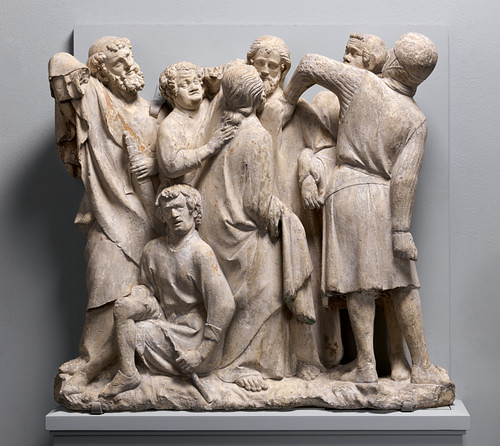
The gospels report a series of evening and morning trials in front of different groups (the Sanhedrin, the ruling Council of Jerusalem, the high-priest), and Jesus was condemned for blasphemy. Jesus was innocent of this charge, but the gospel writers knew how Jesus died and used blasphemy as a plot device to hand him over to Rome.
Jesus was executed on a Friday afternoon. Saturday was the Sabbath, which began at sunset on Friday, and so the women could not go to the tomb until Sunday morning to finish the funeral rituals. It was then that his followers claimed that the body of Jesus was gone, that he had been raised from the dead by God. In consequence, the claim was made that Jesus was bodily ascended into heaven.
Jesus of Nazareth as the Messiah
All four gospels had to deal with some problems in their claims that Jesus of Nazareth was the promised messiah of the Jewish Scriptures. Not only was Jesus dead, but he died by crucifixion, as a traitor to Rome. And the preaching of the imminent kingdom of God had not materialized. Two responses arose in the communities of his followers. In chapters 53-54 of the Prophet Isaiah, we have the description of a "righteous servant" who is tortured, suffers, dies, and then is elevated to share the throne of God. In the historical context of the Prophet Isaiah, the suffering servant stood for the nation of Israel. Early Christians now claimed that Isaiah was predicting that Jesus of Nazareth was this suffering servant.
The problem of the fact that the kingdom of God did not materialize when Jesus was on earth was resolved by another Christian innovation. This is known as the parousia or second appearance. Jesus, now in heaven, would return at a future date, and then the remaining elements of the reign of God would be manifest on earth. This conviction remains central to Christianity, where the details were outlined in the Book of Revelation by John of Patmos.
The followers of Jesus took his message to the cities of the Empire. Surprisingly, Gentiles (non-Jews) wanted to join. Initially, a debate arose over whether they should fully convert to Judaism first (circumcision, dietary laws, and Sabbath observance). The decision was made c. 49 CE in Jerusalem against this requirement. But they did have to follow Jewish incest laws, eat no meat that had blood in it, and cease idolatry to the traditional gods of the Roman Empire. Preaching against traditional Roman religion later led to the persecution of Christians by the end of the 1st century CE.
After receiving a vision of Jesus (now in heaven), Paul, a Pharisee, joined the movement and began preaching "the good news" in various cities in the Eastern Roman Empire. Within the historical context of Paul's communities, however, this was not a new religion. This was Judaism with a twist. Paul established two-tiered communities made up of Jews and Gentiles, but both believing in the fulfillment of eschatological teachings of the Prophets. Much of his advice in the letters was directed toward the followers of Jesus in terms of how to live in the interim before he returned to earth. Paul expected his generation to be the last of the old order until the transformation of the universe took place through Christ.
The Worship of Jesus as God
It is in Paul's communities that we find the earliest evidence that Jesus of Nazareth was now being worshiped along with the God of Israel (as sharing the throne of God). This worship consisted of prayers and hymns to Jesus, baptizing in his name, exorcising demons in his name, and commemorating his death by meeting together each week to recall the Last Supper. As Paul said, "every knee should bend" before Jesus, the age-old ritual of veneration to a god.
In Paul's letter to the Romans, we find the first reference to what would constitute the understanding of the death of Jesus as atonement. Atonement referred to a sacrificial ritual that would fix or atone for a violation against a commandment of God. In Romans 5, he applied the analogy of "first man, last man." Adam, the first man, sinned, and his punishment was death for his descendants. Jesus, the last man, died and brought eternal life. This became understood as the rationale for the death of Jesus of Nazareth: Jesus died not simply for our sins but for the punishment of our sins, physical death. To be saved through faith (loyalty) to Jesus, meant that when Jesus returned, his followers would be transformed into spiritual bodies (no longer flesh) and co-rule with Christ on earth (1 Corinthians 15). After the first generation did indeed die, the concept was adjusted to the idea that though we would continue to die, nevertheless, believers could enjoy an afterlife in heaven.
In the middle of the 2nd century CE, Christian leaders (mostly bishops) later designated as Church Fathers, began writing apologia to Roman Emperors and others in defense of Christianity. As educated men in various schools of philosophy, they utilized philosophical concepts of the universe and terminology to accord Christian views of Jesus with philosophical claims. Thus, the elevation of Jesus of Nazareth from a Jewish wonder-worker to a source of all power in the universe.
Sources for the Life & Ministry of Jesus
We have no contemporary sources for the life of Jesus and his ministry; no one at the time wrote anything down. Contrary to popular belief, the gospels were not written by the disciples of Jesus. In fact, the gospels existed for about a hundred years before later Christians assigned names and authorship to them. The immediate background for the gospels was the Jewish Revolt against Rome (66-73 CE), which ended with the destruction of both Jerusalem and the Temple. This was eventually blamed on the Jews collectively, as a punishment for their rejection of Jesus as messiah. Gospel writers distinguished between their Jews and rebels by presenting the death of Jesus was as a result of religious differences with the Jewish leadership. Having a Roman magistrate declare Jesus innocent meant that, by implication, his followers were innocent of treason as well.
The earliest non-Christian sources for Jesus are found in the works of Flavius Josephus (36 - c. 100 CE), a Jewish general during the Revolt. He changed sides and later moved to Rome to write several volumes of his history of the Jews. Preserved by Christians, these works related the story of the death of John the Baptist (different than Mark's version) and the execution of James, Jesus' brother in the year 62 CE. There is also a controversial passage known as the Testimonium Flavianum. The Testimonium acknowledges Jesus as the Christ but remains controversial as nowhere else in his writings is Jesus mentioned again. Scholars debate if this section was added by a later Christian.
The first Roman sources come from later writings. Pliny the Younger (governor of Bithynia on the shores of the Black Sea) wrote about Christian trials c. 110 CE. The historian Tacitus (writing around 110 CE, followed by Suetonius, c. 120 CE), related the story of Nero's (r. 54-68 CE) persecution of the Christians in Rome after the great fire in 64 CE.
Christianity as Legal Religion
For roughly 300 years, the Christians were persecuted by Rome for angering the gods. In 312 CE, Constantine I (r. 306-337 CE) battled other contenders for the title of Emperor of the Western Roman Empire. He won at the Battle of the Milvian Bridge in Rome and credited the victory to the
God of the Christians. Christianity was now a legal religion through the Edict of Milan in 323 CE, no longer subject to persecution.
During all this time, there was no central authority such as the Pope in the later Vatican to determine standard Christian beliefs and rituals; communities literally followed the teachings of their leaders (now bishops) and continued to argue with each other. When Constantine the Great converted, he opted for the teachings of the Church Fathers which would ultimately become the standard theology of Christianity.
Around 325 CE, Christian communities were debating - sometimes violently - the relationship between Jesus and the God of Israel. Constantine called for an ecumenical meeting at Nicaea in modern-day Turkey to settle the issue. The result of this meeting was another innovation, the Nicene Creed, that all Christians were to believe. Retaining their inheritance from Judaism, the God of Israel was the greatest god but now was to be worshiped simultaneously with Jesus as the identical essence of God, along with the spirit of God (the Holy Spirit); this concept became known as the Trinity.
One final element was resolved at the Council of Chalcedon in 451 CE. This involved the human or divine nature of Christ. After a series of debates, leaders met to decide the issue and declared that Jesus was of two natures, simultaneously human and divine. The two natures never impinged upon each other; they remained unique and distinct elements of Jesus of Nazareth.
Modern Christianity
In 1053 CE, Christian churches in the Eastern Empire and Western Empire split over doctrinal differences. The Eastern churches are collectively referred to as Orthodox communities. The Byzantine emperor in Constantinople was the supreme head of these communities until the Muslim conquest in 1453 CE under the Ottoman Turks.
In Western Europe, the medieval Church was dominated by the Vatican, headed by the Catholic Pope in Rome. In 1519 CE, an Augustinian monk by the name of Martin Luther rejected many of the rituals and beliefs of this system and created what became the Protestant Reformation. Luther focused on faith alone as the way to individual salvation.
During the period of colonial expansion, Christian missionaries took the teachings of their various communities to China and Japan, Africa, and the Americas. Today, Christianity is one of the largest of the world's religions at c. 1.3 billion adherents. While living in a secular world, our calendar nevertheless remains highlighted by Christian holidays that re-enact events from the life of Jesus.

